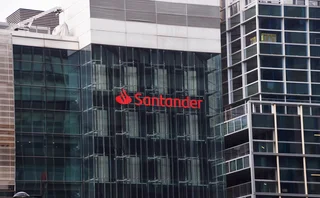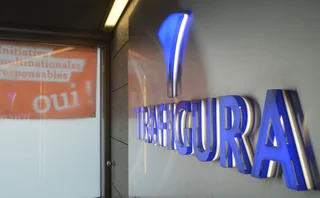

9/11: the colleagues we lost, and the years that followed
On September 11, 2001, Waters magazine, one of the two publications that gave their name to Risk Waters Group, held its first-ever conference. It was an exciting and stressful time for the editorial, sales and events teams. The magazine was eight years old, and there was a youthful exuberance about the company, imbued by its staff, who were mainly in their 20s and 30s. Some were just starting families. Several flew over from London, the company’s head office.
It has been 20 years since that day. Of nearly 3,000 people who were killed in the terrorist attacks, 16 were members of Risk Waters, and another 71 were delegates who had arrived to catch the morning presentations or settle in before participating in panel discussions scheduled for later in the day. Another 72 restaurant staff were already well into their shifts, having arrived early for breakfast preparations.
Peter Field, the chairman and chief executive of Risk Waters Group who had flown over from London for the conference, had planned to arrive before Waters magazine editor David Rivers gave his opening remarks at 8:30am. But before Field left his hotel that morning, he noticed he was unable to receive emails, which delayed his arrival while he tried to resolve the issue over the phone with the IT team back in London. At 8:46, as the first plane hit the North Tower, Field was arriving at the subway station beneath the building. As you can read in his stark remembrance from 2002, by the time he was above ground and outside, the second plane had struck the South Tower. He scrambled for cover.
The memories from that day are still fresh for Field.
“I don’t think I really see it very differently to how I did then,” he says today. “Obviously, I block it out to some extent – I’ve had to, to get past it. The horror isn’t there, but all the memories are there, and I’d prefer not to think of that too much. I pay my respects by thinking about it now, but come September 12, I put it to one side until next year, and I don’t think that will change year after year. I don’t see much significance in 20 years, or any anniversary, because I spoke with Neil Cudmore’s dad a few weeks ago and he said he thinks of his son every day. That’s the way it gets you.”
The promise we’re trying to keep
Risk Waters lost nearly a tenth of its workforce on 9/11. We have often said we wouldn’t forget our friends and colleagues, and we wanted to live up to that promise – we hope we have. In doing so, we hope we have also preserved something of our company’s history.
Click here to read more about this project.
Jared Kotz, who worked in delegate sales for Waters, was at Windows on the World that morning. He was helping the event manager, Paul Bristow, who was over from London, set up the stand that showcased the various publications under the Risk Waters umbrella. Kotz was slow to arrive because he took the time to tend to an injured bird he’d found on the street. By the time he got to the 106th floor, Bristow had most of the stand ready to go, but there was one batch of publications missing. Kotz, who rode his bike to WTC, offered to go back to the Lafayette Street office to grab the magazines, which would also afford him time to check on the bird. He was outside when the first plane hit.
“Paul is responsible for my being alive because he got there early and pulled all our marketing materials out of the boxes and placed them in the displays, a job I was slated to do,” Kotz says. “If he hadn’t done that work, I would have still been there when the plane arrived. I needed an excuse to leave and go rescue that bird and Paul’s efforts allowed me to make the choice that took me out of harm’s way.”
Oliver Bennett
“Oli’s charity is thriving, 20 years after his death and we have supported 150 young people in their ambition of setting up their diverse businesses.” Read Joy Bennett’s tribute to her son.
These are just two of the stories of chance that led some to safety that day. Sadly, there are more stories of tragedy than luck, as you will read in the remembrances linked throughout this article. While it will likely offer little or no solace to those who lost a family member, friend or colleague, the people at Waters (now known as WatersTechnology) and Risk are still producing journalism and hosting conferences, two decades later. Most importantly, friendships are being forged all the time and new relationships are being struck up.
Tony Gibson, former publishing director and board director of Risk Waters, was in London on 9/11. He says no one ever talked publicly about what transpired after those terrible events because – rightly – the focus was on the families of those who were lost. But he hopes people don’t take that silence to mean those who died were ever forgotten.
“David I knew very well. For him, Waters was in his blood. How would he have felt if the company had collapsed? Neil, I spent hours on the phone [with every week], and I even convinced him to move to New York from Hong Kong. How would he have felt if we hadn’t continued?” Gibson says. “We still remember them. And I hope they would be proud that we’ve kept what was such a major part of their life still going.”
In the aftermath
Nat Knight, the former regional director for the Americas with Risk Waters, would normally have been at an event like the Waters 2001 Financial Technology Congress, but he was in Chicago. Like many around the world, all he could do from that distance was hope.
“I remember waiting for my first meeting and seeing on a small TV the first plane crash into the towers, and failing to understand the effect this would have,” he says. “My meeting was cancelled and I went back to the hotel. I tried calling several of my colleagues who were supposed to be at the event, but everyone’s cell went straight to voicemail. As the day unfolded, I finally managed to contact the New York office, who were relieved to hear I wasn’t there, and the truth slowly dawned: while I hoped they had got out, it was fairly clear they hadn’t. I still feel sad that their lives were taken away from them, and often think, ‘What if we had held the event on another day…’”
Melanie de Vere
“Melanie was a great person with a fabulous smile, who would have loved her opportunity to continue her journey through life.” Ruth de Vere remembers her sister.
Hope can be a powerful drug. In the immediate aftermath, Gibson remembers a delegate calling and saying he got out. Perhaps others had, too? Many held on to that hope for several more days – even weeks – as false reports of survivors came in. The internet was young and buzzing, while official information was released slowly.
“The level of communication back then and awareness and knowledge was so far below what we have today,” Gibson says.
It was up to the London office, led by Gibson and Celine Connell, former publishing director and board director with Risk Waters, to field the frantic calls from loved ones. Due to the confusion and lack of real-time information, those in London had just as much news as those in New York, which created problems.
David Osborn, who headed the UK Metropolitan Police’s family liaison team responding to the attacks, offers a reflection here on how his officers did their utmost to overcome those challenges, together with Pauline Coutts, HR director of Risk Waters at the time of the attacks and her team, who did all they could to support families who had lost loved ones, often as their first point of contact afterwards.
“To some extent, in New York we were not better informed than people in London,” Field says. “People would come to New York because they thought they’d find out more, but they were disappointed that we knew no more than they did.”
Shut out of the office on Lafayette Street after downtown was closed off, staff in New York did what they could, travelling “around the city, checking hospitals and medical centres, posting ‘missing’ pictures on walls, desperately seeking any clue to our colleagues’ whereabouts,” he says.
Simon Turner
“Those who knew Simon in the industry would remember a gregarious, sociable extrovert, and his job complemented all these qualities.” Elizabeth Turner celebrates her husband’s life.
Ben Ray, Waters’ group publishing director at the time, was one of the key conduits on the ground in New York for families looking for any information. He says that it would be several months before he was able to properly grieve because each day there was so much to do. “I think adrenaline was my biggest driver at that time, after perhaps the first couple of days of confusion which was flowing from the usual media sources. Reports of walking wounded and evacuations to NJ proved false and the penny dropped for me when I decided to go and visit some hospitals and the city morgue. They were completely empty.”
He continues: “I stayed in the office all day, taking calls from family members and friends and then over the next days went through dead colleagues’ phone messages and got back to family members and friends. That wasn’t easy, but relatively speaking I held the easier end of the line. I recall clearly several of the calls or later in person meetings with family members. There was a mix of panic, anger, frustration, and also compassion and level-headed pragmatism. Some of the anger was directed at me but you can’t judge that emotion – it is unfiltered, raw and you have to respect and let it come.”
In London, Gibson handled enquiries about delegates, while Connell spoke with families of staff. Gibson remembers, though, that “everybody wanted to help – everybody wanted to help.” And they did, in something of a “shift” arrangement, tackling day-to-day tasks, and then manning the phones or helping in other ways. Connell pays tribute to everyone on staff, “who, after the events of that appalling day, rallied and nobly laboured away in horrendous circumstances as they watched and waited, in the midst of their own grief and despair.”
Karlie Rogers
“At 26 she was just starting out on a life that should have been filled with adventure, love, laughter, fun and undoubtedly the patter of little footsteps.” Keith Rogers describes his daughter’s life and legacy.
As days went by, what was left of hope dwindled. “I did a town hall on the Wednesday, Thursday, and even on the Friday. I still said we hoped we’d have news on the Monday,” Gibson recalls. “That is naive with hindsight, but it is genuinely what we believed. I think Monday was the last day we did a daily briefing.”
Attention slowly turned to the company, and the more than 200 employees who worked at Risk Waters, according to Field. “For the first couple of weeks it was pretty chaotic, but at some point we had to get on to the business, otherwise people would’ve lost their jobs, as well. It’s not the same as losing a friend, a child, or a partner, but it focuses the mind.”
There were still deadlines to hit, and there were still events on the docket. Just a few weeks after the attacks, Gibson and Connell boarded a plane to New York to attend a Risk event.
“I remember driving away from my home to go to the airport and looking back at the house and thinking: we’re going to New York right after September 11 – am I mad? Will I ever see this again?” Gibson says.
Building a company
Risk Waters Group was created in 1999 when Risk – the publication founded by Field – acquired Waters magazine. As Kotz remembers, the two organisations were still integrating in 2001. Just like any office dynamic anywhere, things could get “testy”, he says. “But once people got to a bar after work, things were more gregarious.”
Over the year that followed, Field remembers people left the company because the sense of loss was too great. Kotz says “it was just grief” in the office. For some, moving on would be easier than for others. “New people came in and got to work and the business of publishing continued,” he says.
Neil Cudmore
“I remember sitting with Neil watching the sun go down over Lamma Island, listening to a James Taylor CD, “You’ve got a friend”, and enjoying a few brandies.” Jim Cudmore recalls a trip to Hong Kong to see his son.
Family members eventually came by the office to remove personal items from desks or reclaim luggage from hotels.
One thing that indelibly sticks with Kotz is that the smell of the attacks – the acrid smoke – didn’t leave the city for a long time.
“In the coming weeks I learned what war smells like,” he says. “I decided to see a psychotherapist and the one I chose had an office overlooking the pit and so I would sit and look at the site as I tried to process my PTSD and watch as the firemen would line up to honour those whose remains were recovered.”
Some sought out help. Some handled the grief inwardly. As weeks turned into months, funerals and memorial services were held. At some point, memories blurred about the “office culture” before and after 9/11.
“I find it hard to say what the office dynamic was like before, because it was just an office dynamic. It was a very friendly place, and we were always working closely together because you were always working to deadlines, so you socialised a lot, and we were all fairly young. It was a communal thing. I was on the phone almost every day probably for two hours to New York. So there was a lot of flow between us, but I didn’t think anything of it,” Gibson says.
Sarah Ali
“She was always making her family and friends laugh, from the funny voices she would put on, to the hilarious retelling of her adventures.” Sarah’s sisters remember her magical touch.
“Once September 11 happened, I think it just made us all feel a bit more vulnerable. It was a fun company, and I don’t think that changed after, but I think we were just more fragile.”
Ray notes the sales team had to be completely rebuilt, and they had to prove quickly that they could build a viable business model for the publication if it was going to carry on.
“Putting the losses aside I reached the ‘what now’ phase and decided it was to carry on with Waters. The team we put together post 9/11 stayed together for the next seven years or so. I wouldn’t say we were carrying a candle for the dead, but there was absolutely a sense of purpose and we could all rely on each other to do the things we needed to get done. I felt I could trust everyone on the team absolutely – that’s very powerful.”
Postscript
In 2003, Risk Waters Group was acquired by Incisive Media, which was headed by Tim Weller.
Weller had known Field for several years. Field didn’t necessarily want to sell, and even got cold feet at the last minute, but today he acknowledges that 9/11 had “some influence” on his decision to sell, though there were other nuanced reasons, too.
Amy Lamonsoff
“I remember taking her to see Duran Duran. I took her and her friend and it was the best day of their lives.” Wendy Mceneany on growing up with her sister.
Looking back on the acquisition, Weller says one thing that was evident as an outsider was the “extraordinary graft” of those who worked for Risk Waters.
“What we found was an unquestionable resilience of the team,” he says. “I have no idea how they dealt with it all. And I think there was a certain duty to give them focus and allow them to creatively execute stuff. Those folks who took over – it’s just amazing to carry on producing and creating and saving the brand.”
While the magazine that David Rivers edited has been acquired several times – today, we are part of Infopro Digital, a much larger organisation – what Rivers and his 15 colleagues created endures.
Waters was named after founding editor Dennis Waters, and it was Dennis who convinced David to join him in 1990 at what was then Waters Information Services (the precursor to Inside Market Data). David would become the founding editor of Waters magazine. (And we’ll use first names to avoid confusion, as Waters and Rivers are easily entwined.)
Laura Rockefeller
“Sometimes it’s the simplest memories which make you smile when you think back to the time before 9/11.” Pauline Coutts remembers a valued colleague.
Dennis has always spoken fondly of David, but part of what Dennis remembers when he thinks of September 11 is the community those 16 individuals were helping to create. It’s a community that was growing and helped to birth an event that would bring people together at Windows on the World on that bright, blue morning.
“The people who were at this event, didn’t work [in that building]. These were people who were part of a community of IT professionals in the financial markets – that’s what they had in common, they were a community of people who had similar problems, who were dealing with similar technologies, they were trying to adapt their organisations to change. That’s why they were there, but it’s not like they were there every day,” Waters says. “So there was this attraction point for members of that community to come together there on that day.”
When WatersTechnology or Risk have events today, or when our readers browse an article on our websites, they are witnessing the continuation of the energy and enthusiasm of our 16 colleagues, and are part of the same community that brought those 65 delegates together. We will never forget them.
Contributions from former colleagues
To read a contribution from Celine Connell, former publishing director, board director, Risk Waters, click here.
To read a contribution from Tony Gibson, former publishing director, board director, Risk Waters, click here.
To read a contribution from Nat Knight, former regional director, Americas, Risk Waters, click here.
To read a contribution from Peter Field, former Risk Waters Group chief executive, click here.
To read a contribution from Dave Osborn (family liaison officer to Risk Waters), click here.
Only users who have a paid subscription or are part of a corporate subscription are able to print or copy content.
To access these options, along with all other subscription benefits, please contact info@risk.net or view our subscription options here: http://subscriptions.risk.net/subscribe
You are currently unable to print this content. Please contact info@risk.net to find out more.
You are currently unable to copy this content. Please contact info@risk.net to find out more.
Copyright Infopro Digital Limited. All rights reserved.
As outlined in our terms and conditions, https://www.infopro-digital.com/terms-and-conditions/subscriptions/ (point 2.4), printing is limited to a single copy.
If you would like to purchase additional rights please email info@risk.net
Copyright Infopro Digital Limited. All rights reserved.
You may share this content using our article tools. As outlined in our terms and conditions, https://www.infopro-digital.com/terms-and-conditions/subscriptions/ (clause 2.4), an Authorised User may only make one copy of the materials for their own personal use. You must also comply with the restrictions in clause 2.5.
If you would like to purchase additional rights please email info@risk.net
More on Comment
Op risk data: Mastercard schooled in £200m class action
Also: Mitsubishi copper crunch, TD tops 2024 op risk loss table. Data by ORX News
Transforming stress-testing with AI
Firms can update their stress-testing capability by harnessing automated scenario generation, says fintech advocate
Op risk data: Santander in car crash of motor-finance fail
Also: Macquarie fined for fake metals trade flaws, Metro makes AML misses, and Invesco red-faced over greenwashing. Data by ORX News
‘It’s not EU’: Do government bond spreads spell eurozone break-up?
Divergence between EGB yields is in the EU’s make-up; only a shared risk architecture can reunite them
Why there is no fence in effective regulatory relationships
A chief risk officer and former bank supervisor says regulators and regulated are on the same side
An AI-first approach to model risk management
Firms must define their AI risk appetite before trying to manage or model it, says Christophe Rougeaux
Op risk data: At Trafigura, a $1 billion miss in Mongolia
Also: Insurance cartels, Santander settlement and TSB’s “woeful” customer treatment. Data by ORX News
UST repo clearing: considerations for ‘done-away’ implementation
Citi’s Mariam Rafi sets out the drivers for sponsored and agent clearing of Treasury repo and reverse repo







